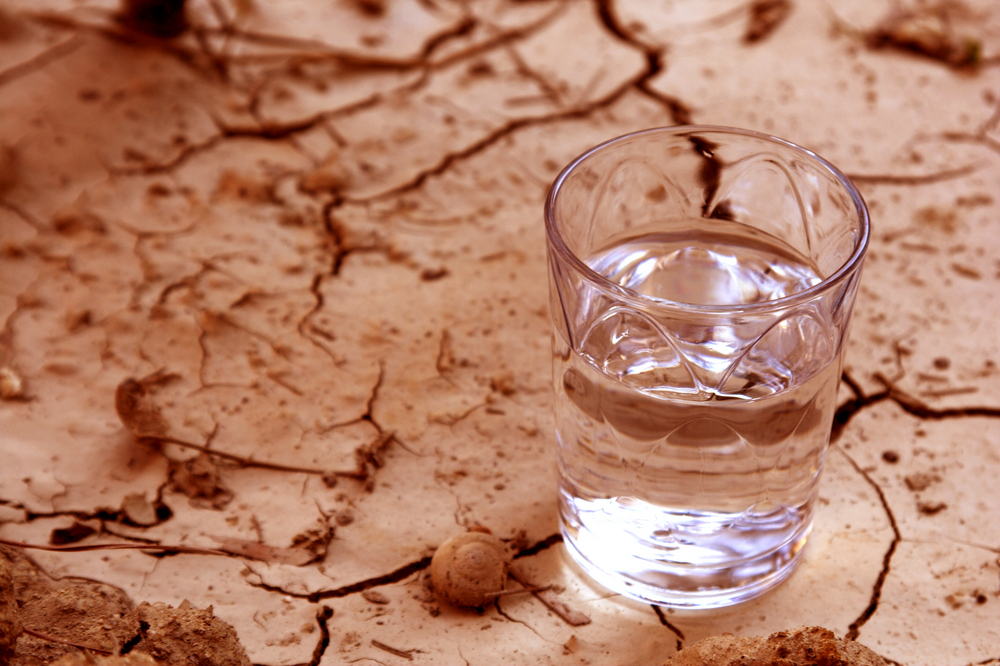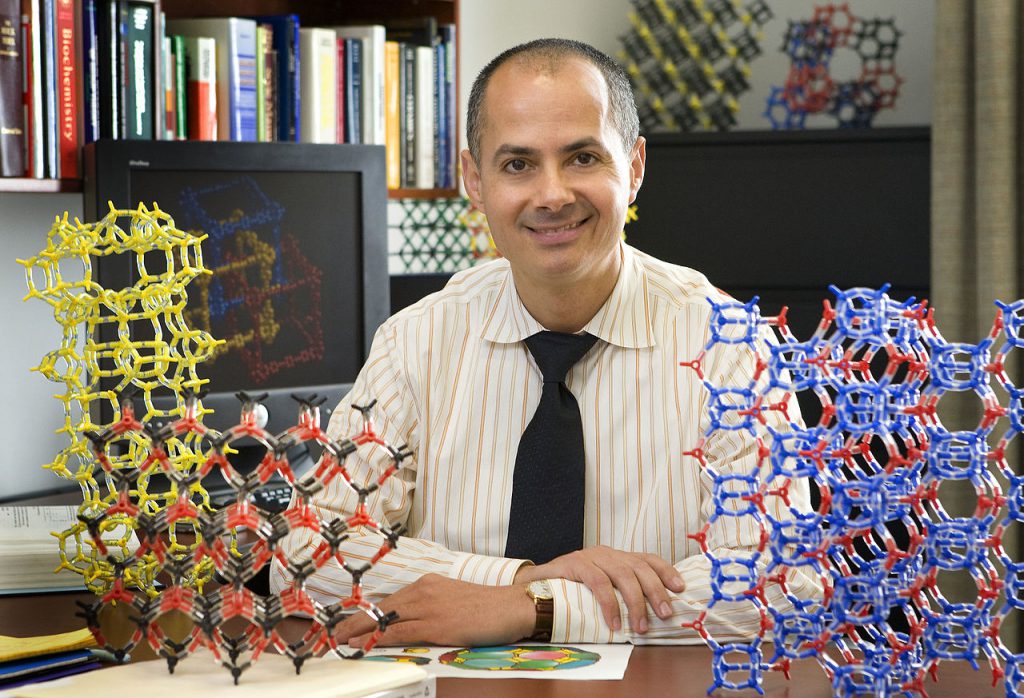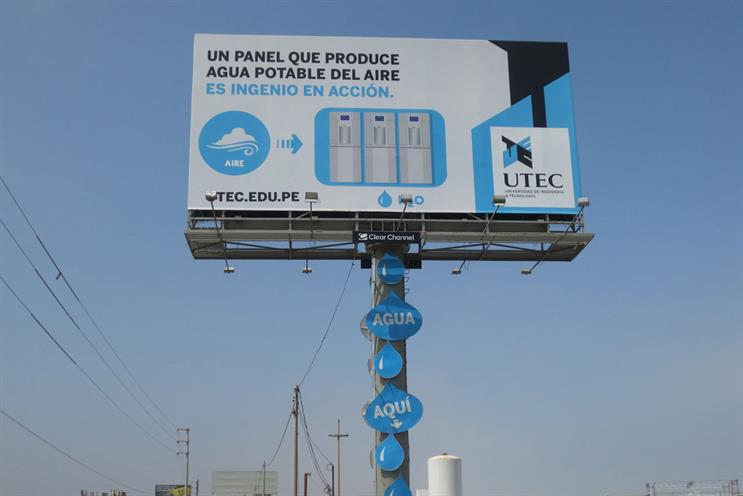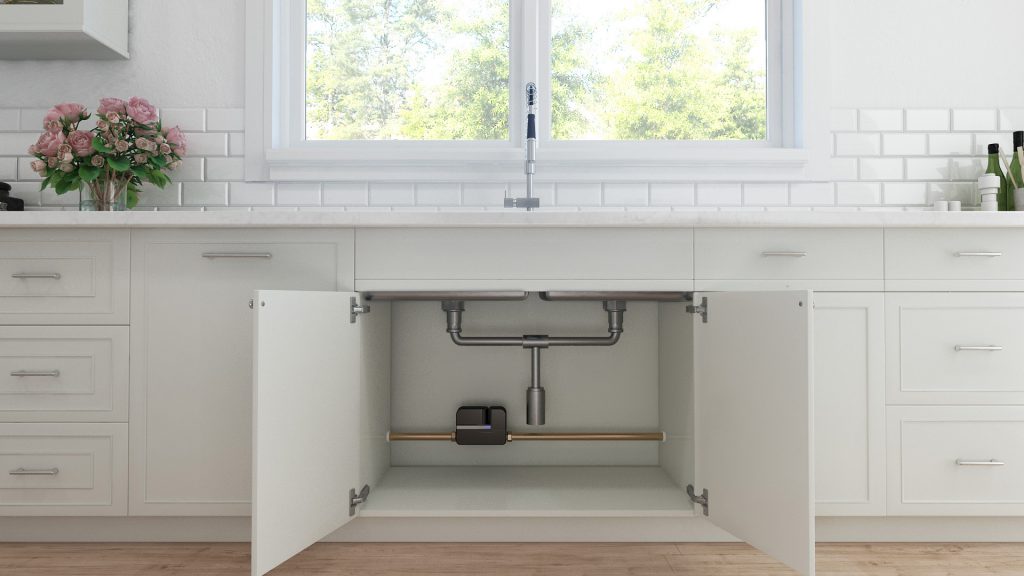
“The vision is to produce water from thin air, just like solar panels make electricity from sunlight”, says Professor Omar Yaghi. He’s an unassuming man, dressed in a neatly pressed suit with and bowtie. The shelves behind him are groaning with awards and accolades. Albert Einstein World Award for Science, 2017 – first place. A plaque from Reuters; naming him as the most cited scientist in the world, 2011. An elaborate trophy awarded by King Abdullah II, ruler of his native Jordan – an Order of Distinction of the First Class of Chemistry. A Nobel Prize, jockeying for position with plastic stick-and-ball models of chemical compounds. There are photographs of beaming scientists from the research centres he set up in Vietnam, Korea, Japan, Saudi Arabia, and of course, his homeland of Jordan.

“What we’re doing here is quite simple”, he says modestly, waving dismissively at his multi-award-winning invention. “Your dehumidifier at home already carries out a very similar function”. Professor Yaghi’s “Water Harvester” sits on the desk to one side – about half a meter cubed, with clear Perspex sides and a square of silvery mesh on top. What he says is technically true, but there’s nothing simple about Yaghi’s Water Harvester.

A New Approach
There are many methods for pulling water from the air – dehumidifiers being one of them – but generally, they require power, maintenance, moving parts. They’re sensitive to temperature and will only work when there’s a baseline level of ambient moisture. They lack the rugged, “set and forget”, solid-state simplicity of a solar panel. In other words, they’re not really suitable for use in the kind of remote locations that generally lack clean water supplies.
Professor Yaghi’s invention is a different breed. Instead of condensers and compressors, it makes use of a unique chemical structure he invented some 20 years ago. Known as a “metal organic framework” (MOF), it’s essentially a powder made of tiny crystals that capture water molecules as the temperature decreases and release them again as it rises. Yaghi describes it as “kind of like a molecular sieve” – a membrane with enormous surface area, such that if one gram of the material was unfolded into a single sheet it would cover about sixty tennis courts.
The Water Harvester harnesses these unique properties to trap humidity overnight and release it into a storage chamber as the sun rises. Every night, it will produce about 200g of water per 1kg of MOF material – and it does it passively, without moving parts, expertise, maintenance or electricity. “If we’re talking pure survival, a person needs about half a litre a day”, says Yaghi. “So you’d need around 2.5kg of MOF per person. The same as say, a medium bag of flour”.
That means desert-dwelling people, nomadic tribes or expeditions headed into the desert could easily carry a loadout of MOF alongside water supplies to replenish their reserves along the route. But Yaghi also envisions normal homes equipped with full MOF plants, in much the same way as we adorn our rooves with solar panels today. A roof-top sized plant could potentially “satisfy the water needs of an entire household using nothing more than ambient light and air”, instead of drawing on our already over-stressed rivers, lakes and aquifers. The current MOF uses zirconium, but an aluminium version that costs 99% less and produces twice as much water is already undergoing testing. “We’ve had enormous amounts of interest”, says Yaghi. Considering that 2.1 billion people worldwide already lack access to clean water, that’s not surprising.
Watch this space
Half a world away in Lima, Peru, the University of Engineering and Technology (UTEC) were trying to work out how to deal with a major slump in new applications. Their core subjects seemed to be losing traction, and they desperately needed a way to demonstrate the value of technology and engineering to would-be students and drum up some applications.
Lima is one of the driest places on earth, with close to zero rainfall – but thanks to a bizarre Pacific-coast microclimate, it also sees humidity in excess of 90% for much of the year. 700,000 people in Lima have no access to clean water, another half a million haul it by hand from a well. Yet clean water hangs in the air all around them, tantalisingly out of reach. As Coleridge would have it, “water, water, everywhere, and not a drop to drink”.
UTEC are all about solving problems with technology, and it looked like they had found their chance. They commissioned a billboard in the Bujama district, one of the most water-poor neighbourhoods in Lima, on a hilltop overlooking the whole city. At its rear, they installed five bulbous metal condensing spheres, each one cooled by a repurposed fridge compressor. As humid air rolls over the frigid condensers, the vapour in it condenses into liquid water and trickles down into holding tanks below. From there it’s purified via reverse osmosis and finally collects in a vessel at the foot of the billboard, where any of the thirsty residents of Lima can collect it free of charge. “Es Ingenio en Accion”, reads the billboard; “that’s engineering in action”.

Since the billboard went up, UTEC have seen nearly a 30% increase in enrolment – and the billboard itself reportedly only cost about $1200 to install, not much more than a conventional advert. UTEC are looking at ways to deploy many more of the condensers around the city by selling advertising space to offset build costs. It looks like science and engineering might enjoy a bit of a resurgence in Peru after all.
The Wonderful Warka Water Tower
UTEC’s billboard is a brilliant idea, but it does somewhat rely on having a team of expert engineers at your beck and call. But what about somewhere like rural Ethiopia, where half the population scrapes by on subsistence farming and fetching water can easily mean a six-hour journey? When basic daily survival consumes 95% of your waking hours, you’re unlikely to have much of an appetite for engineering. “If the many failed development projects of the past 60 years have taught us anything,” writes Toilets for People founder Jason Kasshe in a New York Times editorial, “it’s that complicated, imported solutions do not work.” Places like Ethiopia need low-tech, rugged solutions, and ideally ones that can be built locally using the materials available.

Enter the Warka Water Tower, the brainchild of Italian architect Arturo Vittori. Named and styled after an indigenous Ethiopian fig tree, these vase-like structures stand some 30 feet tall and can be hand built from mostly local materials in less than a week, without access to tools or electricity. The web-like exoskeleton is woven juncus stalks and bamboo, making it incredibly strong yet pliable enough to flex in the strong Ethiopian breeze. The internal bag is a mesh net, supplied by Vittori’s organisation at a cost of a few dollars a time – providing a massive surface area for dew and moisture to collect, much like a low-tech version of Yaghi’s MOF membrane.
By virtue of its size and surface area, a single Warka Water Tower can reportedly collect more than a hundred litres of water a day when weather conditions are right – enough to supply the needs of several families. Vittori has designed a number of different versions including massive structures that can supply entire villages and one that integrates with the fabric of a hut, allowing the building itself to become a water-catcher. Yaghi would no doubt be proud.
Smarter Water
If you’re inspired by these water-saving technologies, don’t start growing a stand of juncus stalks in your back yard just yet – we might have a simpler solution. Unless you’re planning a desert expedition or a rural Ethiopian agricultural venture, you can probably find all the water tech you need in our very own smart water meter, Sonic.
Sonic might not be quite as majestic as a 30ft bamboo tower, but it does intelligently monitor a whole home for leaks using sophisticated AI algorithms – and it fits under your sink, which might go down a little better with the neighbours. Sonic can detect all kinds of leakage from the smallest drop to the greatest deluge, and it’s even smart enough to break your water use down into different appliances for you so you can better understand your bill. Pretty smart, right? Join the mailing list to find out when Sonic is coming to your area, and lock in some exclusive offers and discounts too.
For more amazing water technologies, why not check out Detecting Leaks from Outer Space – where we meet leak-detecting drones, blimps, robots and satellites, and even a water-saving AI with a taste for Coca Cola. No, really.
